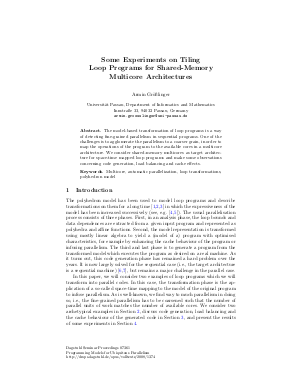Some Experiments on Tiling Loop Programs for Shared-Memory Multicore Architectures
Author Armin Größlinger
-
Part of:
Volume:
Dagstuhl Seminar Proceedings, Volume 7361
Part of: Series: Dagstuhl Seminar Proceedings (DagSemProc) - License:
 Creative Commons Attribution 4.0 International license
Creative Commons Attribution 4.0 International license
- Publication Date: 2008-02-06
File

PDF
DagSemProc.07361.5.pdf
- Filesize: 470 kB
- 12 pages
Document Identifiers
Subject Classification
Keywords
- Multicore
- automatic parallelization
- loop transformations
- polyhedron model
Metrics
- Access Statistics
-
Total Accesses (updated on a weekly basis)
0PDF Downloads0Metadata Views
Abstract
The model-based transformation of loop programs is a way of detecting fine-grained parallelism in sequential programs. One of the challenges is to agglomerate the parallelism to a coarser grain, in order to map the operations of the program to the available cores in a multicore architecture. We consider shared-memory multicores as target architecture for space-time mapped loop programs and make some observations concerning code generation, load balancing and cache effects.
Cite As Get BibTex
Armin Größlinger. Some Experiments on Tiling Loop Programs for Shared-Memory Multicore Architectures. In Programming Models for Ubiquitous Parallelism. Dagstuhl Seminar Proceedings, Volume 7361, pp. 1-12, Schloss Dagstuhl – Leibniz-Zentrum für Informatik (2008)
https://doi.org/10.4230/DagSemProc.07361.5
BibTex
@InProceedings{grolinger:DagSemProc.07361.5,
author = {Gr\"{o}{\ss}linger, Armin},
title = {{Some Experiments on Tiling Loop Programs for Shared-Memory Multicore Architectures}},
booktitle = {Programming Models for Ubiquitous Parallelism},
pages = {1--12},
series = {Dagstuhl Seminar Proceedings (DagSemProc)},
ISSN = {1862-4405},
year = {2008},
volume = {7361},
editor = {Albert Cohen and Mar{\'\i}a J. Garzar\'{a}n and Christian Lengauer and Samuel P. Midkiff},
publisher = {Schloss Dagstuhl -- Leibniz-Zentrum f{\"u}r Informatik},
address = {Dagstuhl, Germany},
URL = {https://drops.dagstuhl.de/entities/document/10.4230/DagSemProc.07361.5},
URN = {urn:nbn:de:0030-drops-13748},
doi = {10.4230/DagSemProc.07361.5},
annote = {Keywords: Multicore, automatic parallelization, loop transformations, polyhedron model}
}
